Text
3D Practical Work from Mark-Making
At this point, I am aware of the multiple routes my Psychogeography and Dustin Yellin research could have taken me down, briefly listed below:
- 3D Mountboard work derived from my mark-making sketches (which is presented below)
- Coding shapes from my mark-making sketches
- Using Audio for my own debates (on topics which I am going to discuss with further detail in my Evaluation)
- Producing Dustin Yellin - inspired 3D works using Acetate (from my mark-making work)
And these are only a few of the many more ideas that can be formed with just a little more thought. However once again, there was just not enough time to pursue so much in such a small amount of time.
I also wanted to leave the Module with doors wide open to the potentially infinite ways these ideas could develop further. And perhaps, pursue some of these ideas in the next module.
But back to my 3D Practical work, so I wanted to use Yellin’s ‘layers of glass’ idea to produce my own ‘Psychogeographies’ - i.e. my Psychology of Logic. Now what I mean by this is that we all have the same basic human reasoning and understanding, as mentioned before, but how we use it, is what differs. And so how I use mine and the way I understand the world around me is hopefully going to be shown below.

These marks were taken from my final Mark-Making sketch, on the Speakers Corner conversation titled ‘Ex-Christian seeking the truth’. These specific pieces were made from multiple layers of Mountboard glued together, just as Yellin does with his Glass pieces, but on an ever so slightly smaller scale - just kidding, they are actually 15cm square frames (the size was chosen as almost a test sample).
But what I wanted to do here was to take a few marks and words (in this case, one word) and solidify them to encourage reflection, from me first and then the wider audience too. Reflection on the term ‘Purpose’ and what it means but also reflection on the more abstract marks with ambiguity - and that’s where, for me, it gets a little more interesting, because as you are already know, I could practically go on forever about the meaning behind my work:

Now as you can see above, each mark has it’s own number of layers that it infiltrates. The word ‘Purpose’ with 3, the ‘buildings’ with 2, and the book with the cross and tick with 1 (I’ll explain the reasons below).
The book symbol with the tick and cross at the time of listening to the conversation was my way of symbolising the true religion / scripture separated from the false religion or scripture. Brother Shamsi, the speaker in the dialogue, answers the popular question of “If there are so many religions, how do we establish which one is the truth?” to which he responds with “we use our intellect” and goes on to give examples from the Qur’an of order in the universe and the way in which we human beings have been fashioned to function the way we do - for instance, the fact that our eyebrows are placed above our eyes to protect them from the salt in our sweat or how our nose is above our mouth to smell the food before we eat. So at this stage, we are one layer in - by establishing objective empirical evidence for order and ‘purpose’ in creation.
The two towers on the same flat land indicate, as mentioned before, the levelling of the playing field in regards to using our intellect and human reasoning. Not only are the two buildings on ‘equal grounds’ but the buildings themselves are also symmetrical, emphasising how our similarities outweigh our differences, in regards to basic human function. The contrasting building sizes however, is what can differentiate us sometimes, symbolising that what we each find important differs - one mans religion is another mans mockery for instance. So at this point in my work, we are two layers in - shifting the focus from the outer world to our inter-personal selves.
And finally, the word ‘Purpose’ completely seeps through the Mountboard, quite literally:
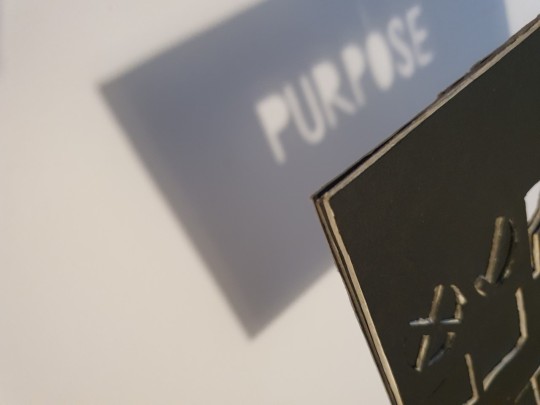
Because of it’s ‘transparency’ in the conversation between the Ex-Christian and the Muslim, I decided to completely allow it to pierce through, making it the focus of this piece. The ‘notes’ I made in the following image sums up why:

These were actually just some rough thoughts I scribbled down whilst in the making of the piece and so decided to include it as almost a ‘key’ to my ‘map’ to manifest my meaning for creating such works - evidently inspired by the countless Speakers Corner debates I ‘binge-watch’.
And so naturally, after every question, we look for answers (which is what I’ve attempted to do below):
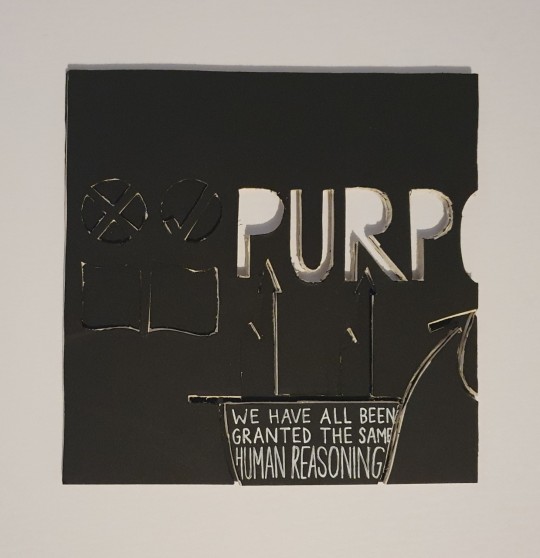
Ironically, these ‘Buildings’ of Logic almost transform into arrows, pointing up at the term ‘Purpose’ - pretty much summing up my standpoint in this little ‘self-debate’. Which goes as follows:
I believe that because everyone’s Human Reasoning and Logic is the same, there must be one objectively true purpose for mankind as a whole, that we can all agree on - whatever that may be.
In summary, If there’s one thing that I would take away from all of this, it’s that with every question, whether correct or incorrect, there are many answers - likewise, with every piece of art, there are also countless interpretations.
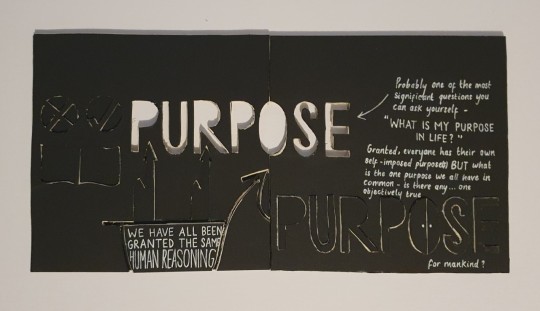
0 notes
Text
Reflection on my Practical Work:
What I wanted to achieve with my Psychogeographical mark-making pieces was practical experimentation - putting what I gathered from my research into action (and in future, hoping to sort of combine together the different blocks of research to create further interestingly-developed practical work). But I admit that taking into account my surroundings and senses when creating artwork is a rare occurrence for me - so to trial something like this was quite unusual but fun to do.
To begin with, I tested the use of my senses integrated into my artwork with various mark-making forms, such as line, hatching, cross hatching, dotted and a bit of squirkling:
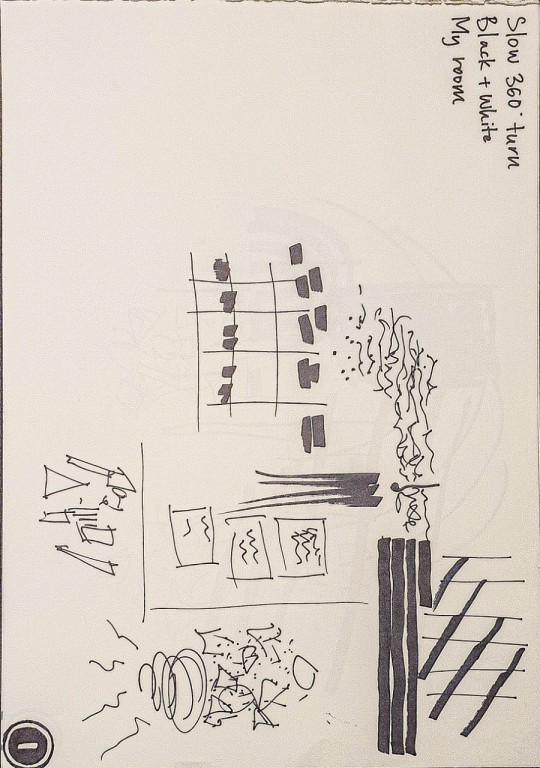
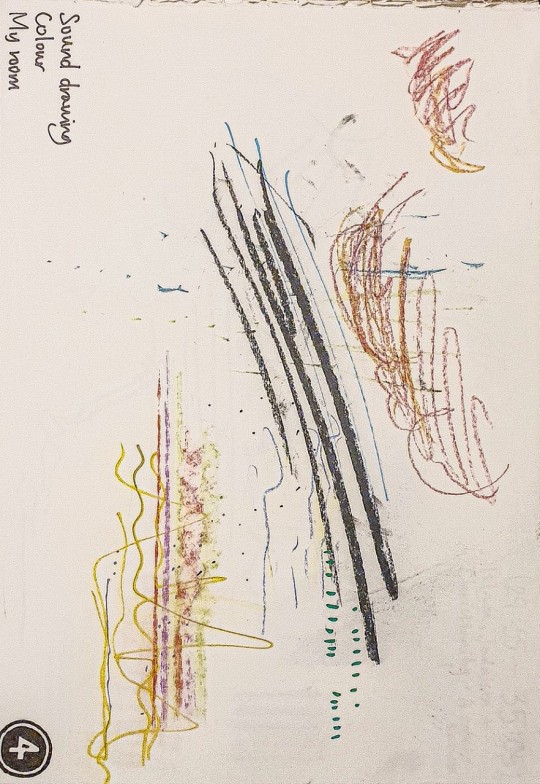
I also experimented with colours to convey perhaps different emotions felt at that moment or meanings such as the use of black to represent the most prominent of my senses which was vision at the time, especially considering the speed of which I was spinning around, where everything around me eventually transformed into harsh black lines (sort of like what is above). Whereas in contrast, the yellow ‘softer’ squiggles mimicking the increase and decrease in sound whilst rotating around.
The materials I used were a variety to add depth and tone even to an abstract piece as reality is not just black and white or consisting of even lines. So I pretty much just threw in any mark-making materials that I had laying around:
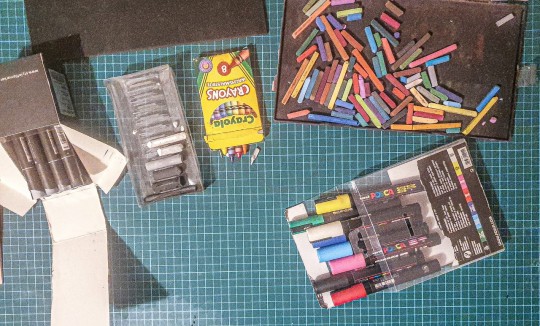
As these were quick sketches, the materials were pre-laid out and quickly picked according to what I believe best fitted my visualisation of the sights and sounds around me. My favourite material to use was probably the pastels, as they covered quite large surface areas pretty quick whilst also being able to make really thin lines when required to. And a close second had to be the Posca pens, simply due to their high contrast with the rest of the materials.
The reason I wanted these to be quick sketches was because I aimed to eliminate second thought during the process, and simply act from first instinct - i.e. the first visualisation of the first sound I could hear. Also, to save more time for the more 3D works I am hoping to create in the next few posts - an extension from these 2D sketches.
0 notes
Text
Practical work: Psychogeography Mark-Making
So advancing from Yellin’s research, I decided to do a bit of my own Psychogeographical work - I admit not on the same level but a few sketches (shown below) to begin with.
I am hoping to explain exactly what I’ve done here in the paragraphs below:
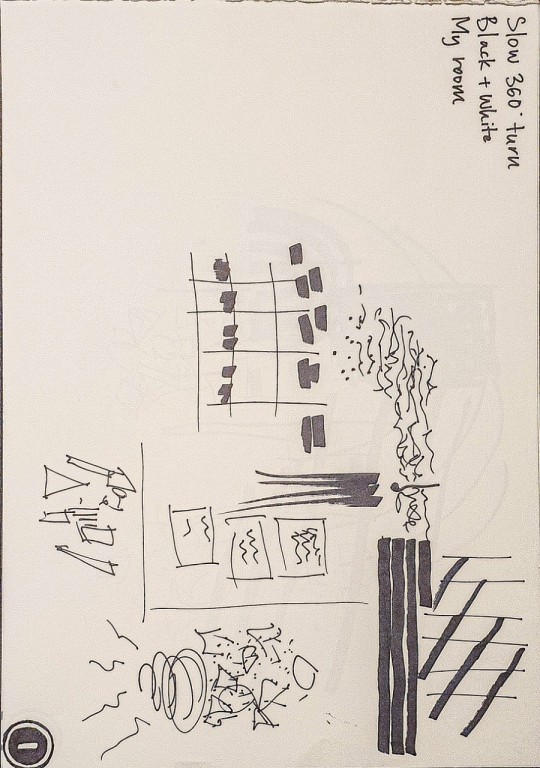
So this first quick sketch took me about a minute, slowly spinning around in my room, mark-making in black and white whatever I could see and hear around me, until I completed the full 360 degree turn. For instance, the grid-like object in the middle of the sheet roughly resembles my oak storage unit in appearance, whilst the ‘squiggly’ lines directly above it visualise the sort of static sounds I could hear from my electrical heater as I was drawing. Now with the heater and the storage unit being at opposite sides of the room, the placement of my marks were, as you can see, very much arbitrary due to the speed I was working at, trying to restrict the length of the sketch as much as possible. But the rest of the sketch pretty much followed in the same manner: with the flat lines resembling the bed, the ‘mini tornado’ with ‘lightning bolts’ coming out of it (at the bottom of the page) mimicking my light bulb, and the extra shapes floating around representing the clutter of small objects on my desk.
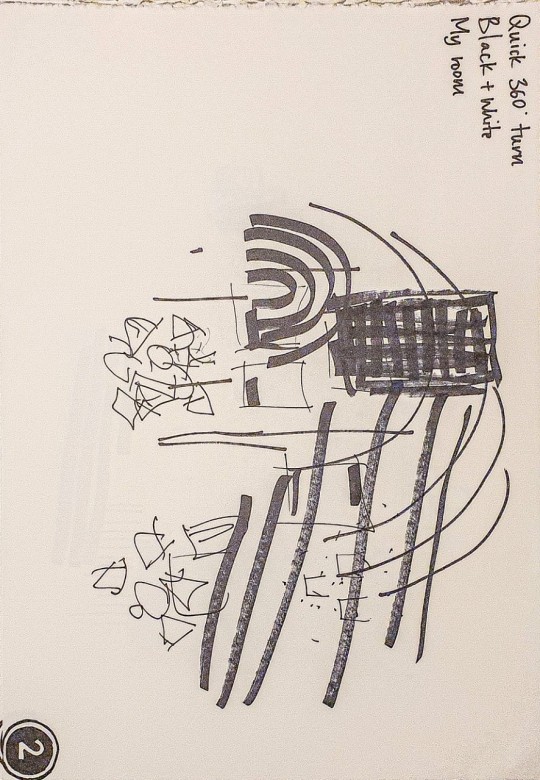
This second sketch was done in the same manner, but just speeding up the process of the spinning around, which essentially created blurred lines through vision, and even distorted my sound to seem louder at points and quieter at others, hence the mess above.

I then repeated the first process but in colour, to sort of distinguish the objects in my room, with the storage unit as the focal point this time (as I started in the direction of it) and everything else stemming from that drawn around it. Again, the dotted mess on top of the unit was my way of visualising the sounds I could hear, of not just the electrical heater this time but the howl of the wind coming from the gaps of my windows.
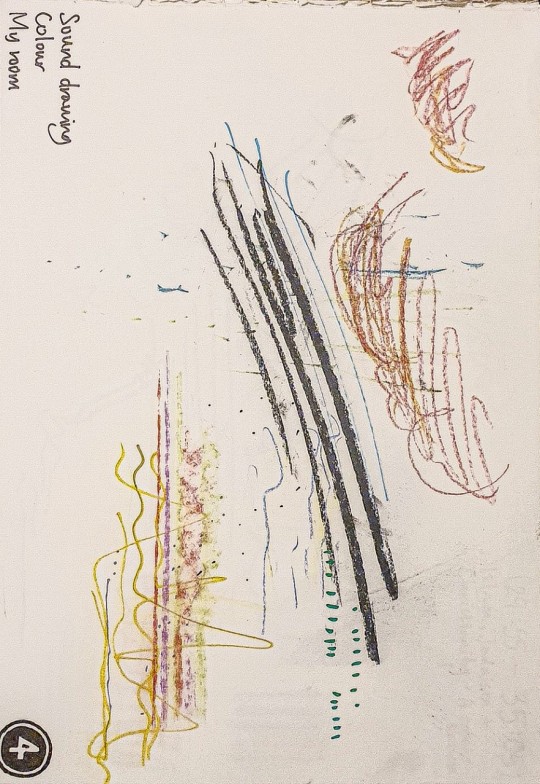
The last of my sketches from this series was a repeat of the second process but in colour. Again, with the speed that I was working at, most of the visuals and sound sort of blurred together, which I actually found quite interesting - I realised the best part for me about including your psychogeography in your artwork was the consideration of an arbitrary mixture of your senses, whether they blend together smooth-fully or not, it would definitely result in a fascinatingly unique outcome each time.

Link: https://www.youtube.com/watch?v=INIG636SnU4&t=1876s
And now, here’s where it got a little more interesting. So rewinding to my Mohammad Hijab debate mark-making sketch previously posted, I decided to do a few more sketches to somewhat test just how “fascinatingly unique” these Psychogeographical pieces can get. This time reacting to a lighter debate or rather more of a ‘conversation’, titled ‘Islam, Judaism and Christianity - A Conversation’ (time stamps written above).
Now in this bit of the dialogue, it was the Muslim’s response to a question asking specifically about the holy scriptures and what they mean in the different faiths / how each faith reads their book. And as he was responding, I made some ‘notes’. For instance, when he recalls this social experiment he saw in the Netherlands where they took a copy of the Bible and enclosed it with the cover of the Qur’an and asked strangers on the street to read a verse out of it, the strangers responding with ‘they are who we thought they were’, the coloured yellow square with the red outline was my representation of this experiment - the yellow usually symbolising happiness and optimism (which is what a lot of people try to pose the entire Bible as - disregarding the verses of violence) and the red usually associated with hatred or anger (the reason why, I’m sure, is pretty apparent).
The Imam then goes on to explain the percentage of violence in each scripture (in defence of his religion), but in a quite humorous way to lighten the topic (Old Testament: 5.8% / New Testament: 2.8% / Qur’an: 2.3%). To which I drew a quick sword representing violence, and next to it in orange, a mini paragraph of lines with a word circled and pulled out of context to showcase how distortion of statistics take place very often concerning religion.
Now how the psychogeography of my room played into it was the blurred sound I could hear in the background whilst trying to focus on the sound of the Imam’s speech, represented by the textured blocks in grey to symbolise slight distraction with the clashing of sounds. Also, the rays coming down from the top right corner of the sheet incorporating my vision of direct sunlight hitting my laptop screen whilst watching the speakers speak.
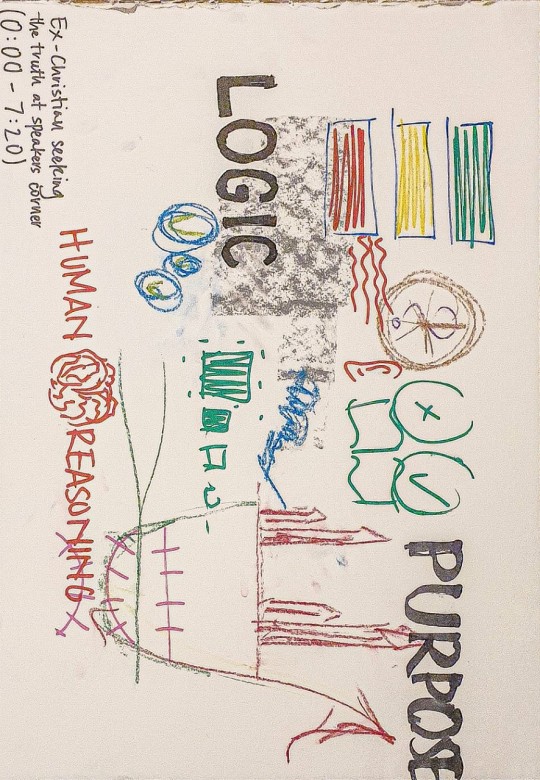
Link: https://www.youtube.com/watch?v=atOJpSzEn2Y&t=450s
This was most likely my favourite sketch in appearance, probably due to the use of text and words being thrown in amongst the chaos of marks. So I was responding to another Speakers Corner conversation between a Muslim by the name of Shamsi and an Ex-Christian questioning him about his religion. It begins with the Ex-Christian explaining his side of why he left Christianity, claiming it was the lack of reasoning and logic for him (hence the words above) concerning the religion. He explains how he got kicked out of an exam when he was younger for asking questions about Jesus, hence the green boxes gradually decreasing in size, from belief with reasoning, to belief without reasoning and eventually to no belief at all, simply because a few fundamental doubts could not be answered (represented with the green dots around the first box).
And again, the grey textured box placed behind the word ‘Logic’ indicates not only background distraction from my side of the screen but also the state of confusion of the Ex-Christian concerning his religion.
What I particularly liked about this conversation was the establishment of ‘Human Reasoning’ as the basics of every human to navigate their life - especially considering everyone’s reasoning is on the same level (hence the red symmetrical buildings indicating the levelling of the playing field when searching for the truth). For me, starting with the similarities between two debaters is one of the best ways to begin - and I believe using logic and human reasoning is a manifestation of exactly that.
0 notes
Text
‘Psychogeographies’


Dustin Yellin’s one of a kind ‘Psychogeographies’ play an immense role in manifesting the artist’s genius creativity and also persona. Since the making of his pieces in 2012, Yellin’s work has been exhibited in numerous museums and galleries in New York as well as internationally. The artist has also given multiple TED talks on where exactly his creativity stems from.
In a YouTube video titled ‘Dustin Yellin Studio Tour’, the sculptor goes a little into depth on how exactly he’s able to create such beauty. His 3000-pound glass sculptures require a number of people to piece together and move around, using ‘optically-transparent’ glue (resembling the glass in colour) to assemble these glass pieces. He also showcases his, what he likes to call, ‘loose-sketches’ of future rockets in his studio, some floating in air and some underneath the sea.

“Ceremony to Build a Rocket on Floating Disc”
Glass, collage, acrylic, resin
2017
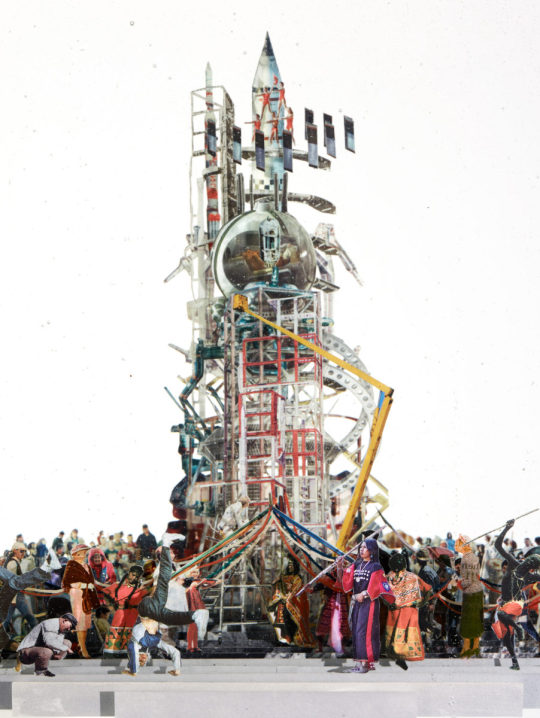
“Ceremony to Build a Rocket on Floating Disc”
2017
Detail
Derived from his 2016 TED talk titled ‘why I think inside the box’ (a play on words might I add), his idea was to create ‘boxes’ of human beings and their culture and interactions with each other i.e. society to then preserve for future civilisations, which all began with his love for time capsules at the age of 8, when he buried a dollar bill, a pen, and a fork inside a box, with the specific idea that aliens might find it in the future. And so the idea of trapping the “catalogue of humanity” was something he was pretty optimistic to showcase. At a later point in his life, he realised he could “draw in the air” using resin, but only until finding out that the resin he was using was actually toxic and slowly killing him - and so he found glass, which was “so much better”, things were no longer stuck, he could go backwards and edit his pieces - according to Yellin, “I could almost control time”. And thus, ‘Psychogeographies’.
Now however, the artist has moved on to creating even bigger boxes, but with “living humans” instead of “drawn humans” - titled ‘Pioneer Works’. This box is “a museum of process” to bring people together, where “it’s not about seeing work finished, it’s about seeing work made and getting made” (something I clearly need guidance with). Inside this box however, lies a residency program, where he provides artists and scientists the space to work next to each other, the idea being to create new combinations instead of getting five artists in one room - e.g. he has had a geneticist and a musician create an algorithm for printmaking, he accommodates science labs where they are working at Nano-scale, and a radio station that prints books and magazines to “disseminate what happens inside this strange box”. He believes by separating the different disciplinaries, “we are seriously inhibiting our potential of wonder and invention” - now, he no longer ‘traps’ and limits the human being in a stationary moment of time but rather encourages communities to move forward by putting “synthesis into action”.
0 notes
Text
3D Cardboard Workshop

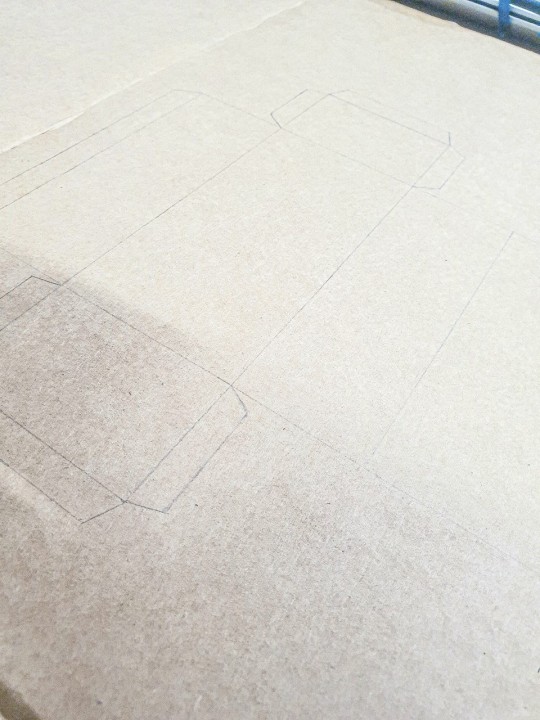


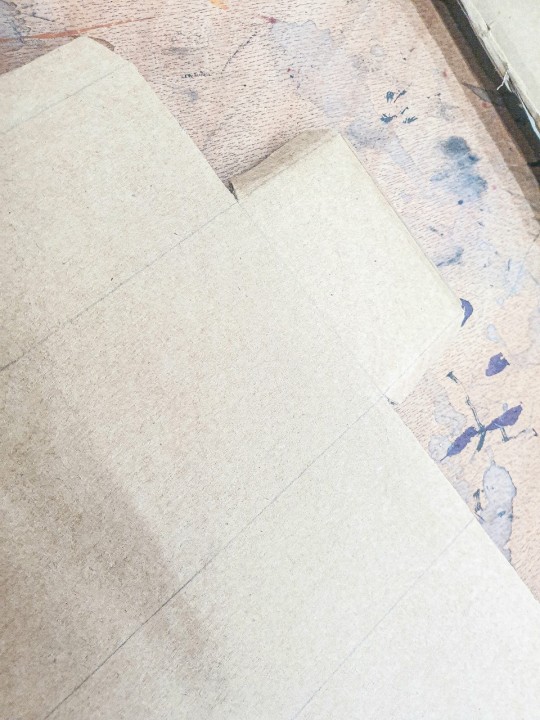
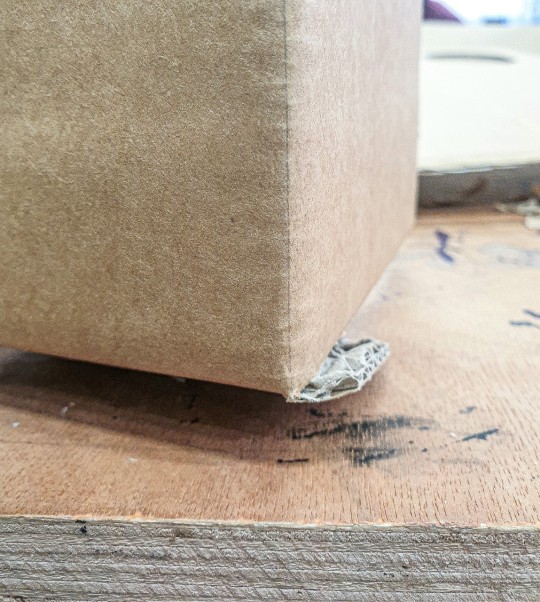
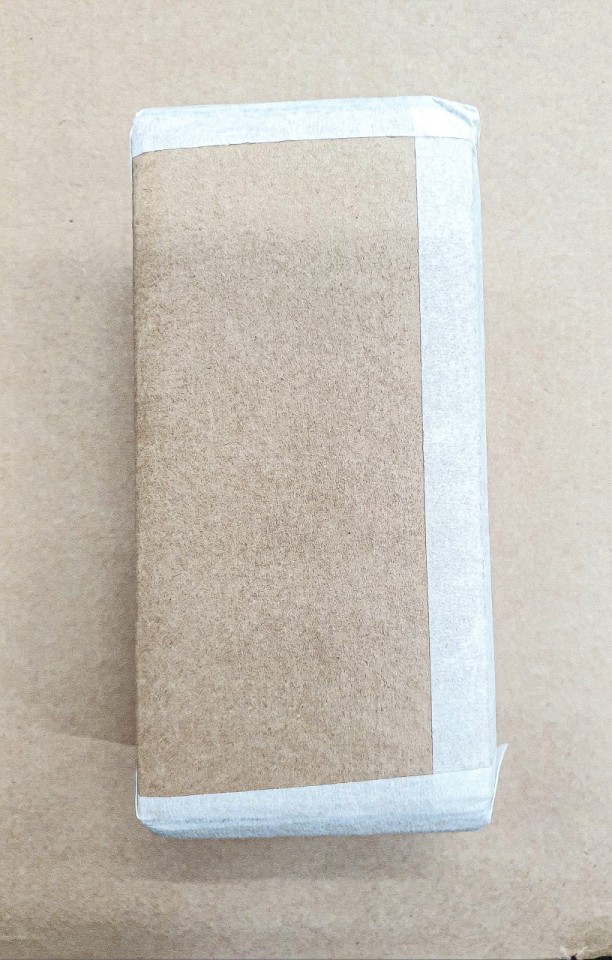
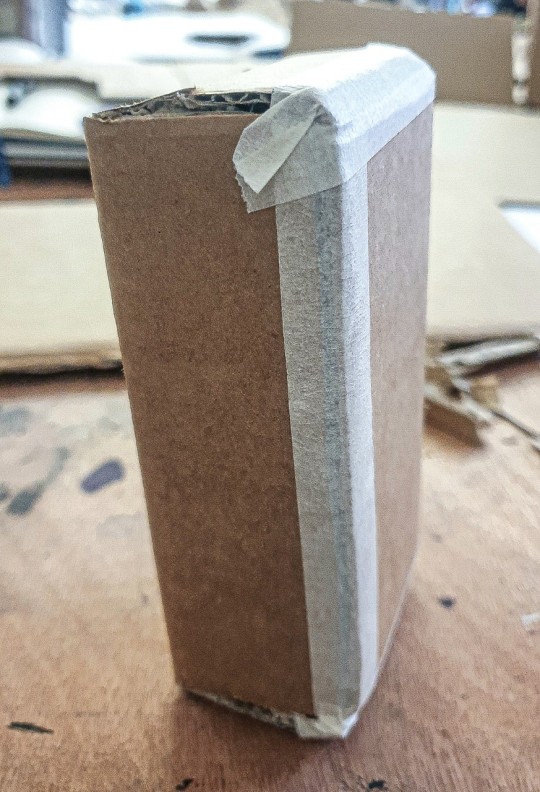
The workshop specifically focused on creating with cardboard, and with so many types, the quality of work we could have created was vast. However, as you can see above, I, on the other hand, did not get very far.
I decided to create a 3D model of a microphone to expand on my logic / debating work, and then perhaps further that with some creativity, but I realised 2 problems during the process: 1 - it was pretty difficult creating a 3D microphone with cardboard (especially thick corrugated cardboard) and 2 - I discovered the irrelevance of it, to the route I wanted to take my project down, pretty quick. So far, my works have been more so related to the intangible rather than the tangible - i.e. my senses. What I mean by this is that for me, playing around with cardboard was not exactly the idea I had in mind for expanding on my ‘Psychogeographical’ works.
That was not to say, however, that I did not learn anything from the experience. As I briefly mentioned before, I found that with cardboard (as with most other materials) there’s not just one type to play around with: rigid, solid, corrugated - which actually further splits into single face, single wall, double wall and triple wall, affecting the width of the cardboard of course. I also recall the different attachment techniques for cardboard thanks to the 3D workshop presentation held by Jo: inserts, flanges, slots - which now recalling, I actually planned to use at one point to create a playfully detachable 3D abstract microphone - the idea being different shapes slotted together to make up the basic shape of a microphone. The deconstruction of the microphone metaphorically representing the deconstruction of an argument within a debate or dialogue. But again, I didn’t exactly know how to physically go about doing that.
To conclude however, the workshop definitely brought me to the next part of my project, which I believe is not only a lot more interesting but also much more relevant to my previous research.
0 notes
Text
Plan of Action

I’m glad to admit all that I have learnt so far has resulted in numerous ideas already, whether successful or unsuccessful, but ideas nonetheless. And so, logically speaking, the next key step would be to organise these ideas to, in a way, differentiate the two types:
1. I plan to upload a post on my experience with the 3D cardboard workshop and whether I found it useful or not.
2. I then plan to execute some of my ideas emerging from my research on Dustin Yellin’s ‘Psychogeographies’ work - starting with more mark-making from sound sketches.
3. And of course, reflecting on these sketches (and any other practical work) to analyse the results.
4. And finally (for now), listing, with elaboration on, the various ideas I formulated but simply do not have the time to pursue in this module.
0 notes
Text
Group Tutorials
Now this was something I found quite useful - in the middle of my module, I fell pretty behind on my project, due to a side business I run as a customizer, and with orders piling up besides my University work, I had a lot of planning and scheduling to do to say the least.
However, one thing I did try to keep consistent was making notes, whether it was on class presentations or extra research. Granted, much of it is yet to be posted onto the blog but the notes were made, mostly to prevent myself from falling further behind. And so this group tutorial with Joe definitely raised my confidence a little in resurrecting my project, with a lot of useful things learnt alongside, for example:
1. Posting that which I might not necessarily pursue - a lot of work I have done so far has been neglected completely, simply due to its difficulty or even irrelevance. And so, for that reason, I tried to almost forget that I even attempted it - an old trick used by a lot of A Levellers in my opinion. But, as I am to coming to realise lately, to bring awareness to even the start of an idea can a lot of the times aid in its development or lead to another stronger idea, which is what I believe happened in my case.
2. I learnt that we could change around the order of the posts - by clicking the 3 dots at the bottom and changing the post’s date and time... so that’s something useful
3. I learnt that this module, or rather any piece of art, doesn’t need to be finished - I’ve realised my previous mistake was channelling all my energy into a final piece despite how clear the command was to do the opposite - I guess now it’s become a habit after A Level Art. But I still don’t think I fully appreciate or yet explored what this actually means - I suppose executing the rest of my project as planned BUT with an open mind should allow me to at least begin to understand what I need to do to develop as a creative artist.
(And the list is practically endless as every idea has its branches, but I am hoping to sort of piece together a plan of action from what I’ve learnt so far in the next post above).

1 note
·
View note
Photo
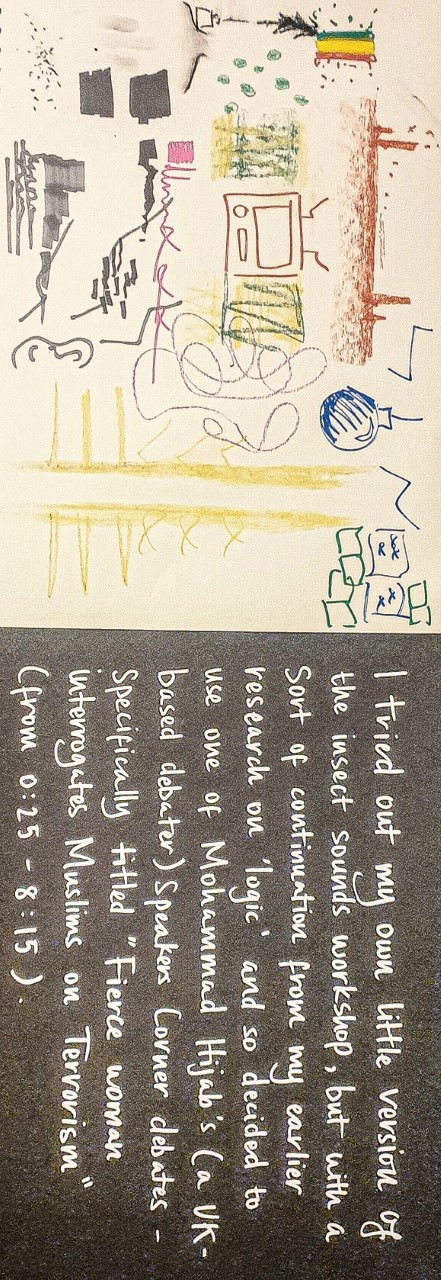
Link: https://www.youtube.com/watch?v=pMqpB4czMcA
The writing on the black piece of paper above pretty much sums up my intentions here but to elaborate a bit, I wanted to apply this interesting idea of creating art from mere sounds to my earlier research focusing on the topic of ‘Logic’, specifically Debating. In my spare time, I love to watch ‘Speakers Corner’ discussions (located in Hyde Park, London) on YouTube - this rough ‘anyone-can-debate’ style really intrigues me and so I wished to perhaps integrate some of these discussions into my Practical Work.
One of my favourite debaters is Mohammed Hijab, famously known for his numerous degrees, namely in Philosophy and History and his extensive use of logic in every one of his debates - and, as I believe, the perfect example of ‘logic in person’. Although a large amount of his work focuses on religious topics, namely Islamic, his discussions extend to topics such as Feminism, Homosexuality and even Liberalism (debated simply through human reasoning).
So what exactly have I done here? Well what I have tried to do is create marks on a blank sheet of paper to the words of the discussion between Hijab and the woman interrogating him. While some of these marks are actual simplified drawings of spoken terms such as “suicide bombing” with the drawing of a bomb, others tend to be representations of what seems to be going on in the debate, for instance, the drawing in red (on the right side of the page) of what seems to look like a mini landscape actually symbolises much more and, from my perspective, pretty much sums up the entire discussion - the line marking the ‘ground’ represents how all humans encompass the same laws of logic and reasoning and so are exposed to the same understanding, the two ‘buildings’ coming out of it signifies both sides of the party agreeing on the fact that something needs to be done about terrorism, but where the line of the top ‘building’ breaks off was my way of indicating the misinterpretation by the interrogating woman of what Hijab was actually saying despite his attempt in breaking down a chunk of knowledge for her to correct her misconception.
0 notes
Photo
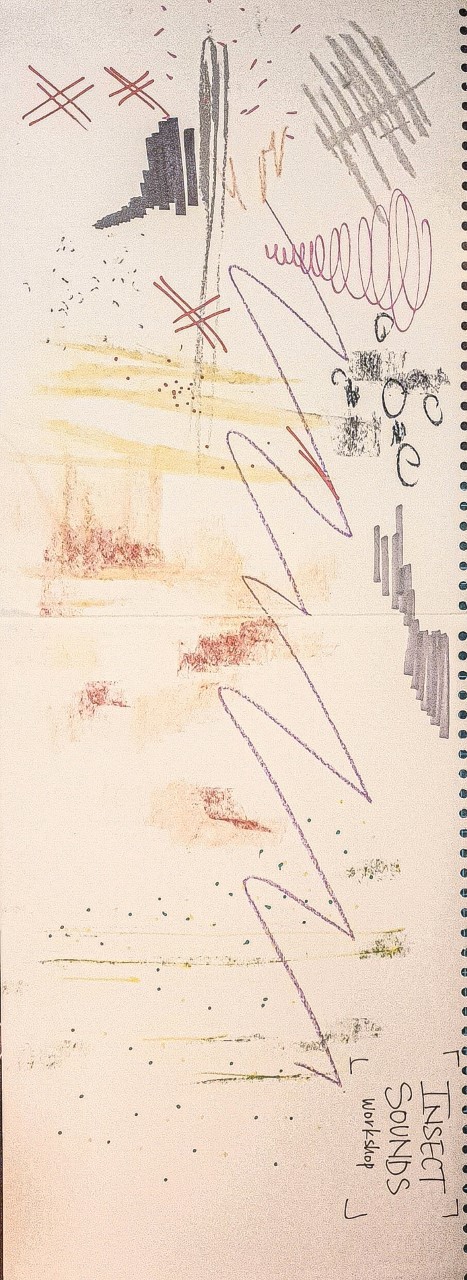
Taking a break from the written side of the module, I attempted drawing from sounds. This specific image above for me was a practice piece, considering this was my first time executing such an activity, quite literally. The outcomes were, as expected, pretty bizarre but then again I think that was the point. One thing I really appreciated, however, was the Abstractivity of such a sketch - despite the sounds being of that from insects, not one of the marks on this page actually look like an insect.
0 notes
Photo
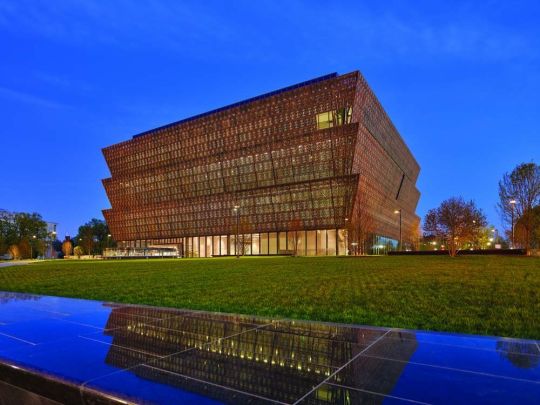
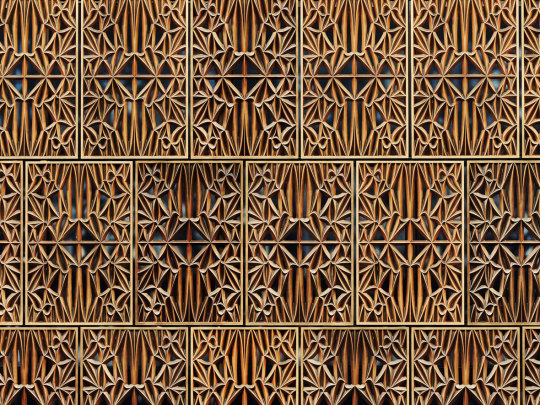
First Image:
David Adjaye
“Smithsonian National Museum of African American History and Culture”
Washington, DC
August 2016
Second Image:
“Smithsonian National Museum of African American History and Culture”
August 2016
Detail
I wanted to write a little bit about why 3D works inspire me - despite my lack of creating 3 dimensional projects so far, the form itself has a lot to do with where I wanted to take this assignment. My work at this stage has consisted of a lot of research from 3D artists, whether it’s in the form of glass, resin or architecture, and so I wanted to incorporate some of their artistically-genius ideas in the hope of creating something distinct from my usual pen and paper work. For instance, the message behind Dustin Yellin’s incredible work on Psychogeographies and the meaning of the ‘box’ in which they are encapsulated in (which I am going to elaborate on in a future post) is definitely something I would like to draw inspiration from.
0 notes
Photo

The third and final block I decided to research derived from the term ‘Morality’ entered into the ‘domusweb.it/en’ search bar, where I came across an article that held a pretty interesting view on architecture - as stated above; “architecture is representation and acknowledgement of others”.
David Adjaye’s view on architecture is one that really opened my eyes to the meaning behind buildings and why we build what we build - in his case, to remove this idea of nations and replace it with one whole planet that we are aiming to better, which he aims to accomplish through building for those who do not necessarily have a voice in a certain area. What I take from this is that if the majority of the World’s morality is currently based upon society’s view as a whole, why not include other societies to ‘update’ these laws based on the majorities understanding of morality instead of a minorities.
For a Muslim, morality is something that is God-given and so objectively-true in contrast to an Atheists perspective in what is right and wrong. This difference in opinion for a topic so big definitely made me want to explore the reasons further, starting from an Architects viewpoint which expresses his morality through construction - buildings that he believes will allow people to live their best lives (how he does it is explained above).
0 notes
Photo

I did find the second block of research much more interesting than the first - probably due to my love of logic (and of course Sherlock Holmes).
Above is the outcome for the term ‘logic’ entered into the ‘bbc.co.uk’ website. Again, I went through each option in the descending order until I stopped on something quite different yet intriguing: time, or rather the lack of or phobia of time. Studying Psychology at AS level, my basic understanding of how phobias work has made me want to study the logic behind it in a little more depth, namely how the role of deduction plays into it.
0 notes
Photo

And so the research begins...
I decided to split this process into smaller ‘blocks’ to distinguish between ideas, hoping to gradually form a unique body of experimental work (involving practice-based works too).
The first ‘block’ is based on my findings from entering the first key term ‘Society’ into the ‘tate.com’ search bar. The result was shockingly extensive to choose from, and so I went through them in the descending order to keep my options open, instead of disregarding that which does not attract me at first glance as I usually do.
The first piece of work I came across was J.M.W Turner’s ‘Modern World’ (specifically referencing ‘Rain, Steam and Speed’ documented below) - I would usually overlook pieces that seemed ‘pre-2000′s’ in appearance but I am glad that this activity forced me to do otherwise. For me, it was the unexpected detail of the train in the painting that transformed my previous opinion - the more we zoomed in, the more history the piece revealed, and surprisingly mid 1800′s society was not that far off today’s in the technological manner. We are still in the mentality of producing the most powerful robots, whether it’s in the form of cars or architecture - the ‘obsession’ has not stopped (and I don’t think ever will).
0 notes
Photo
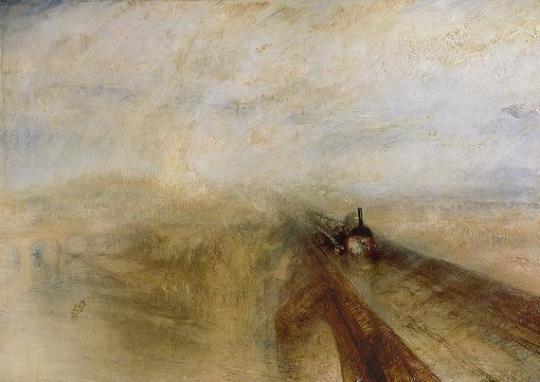
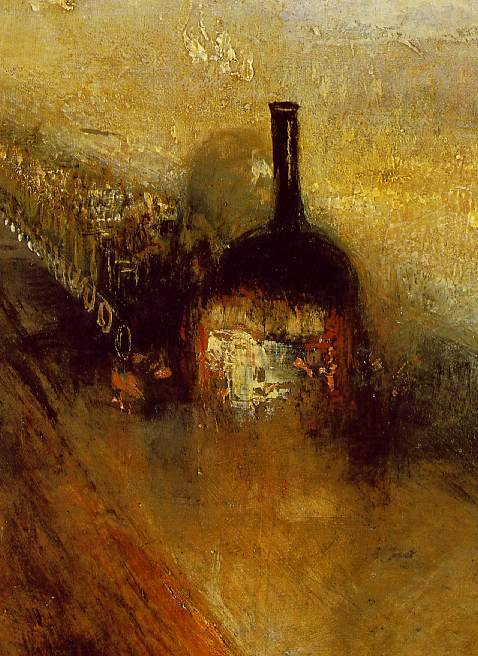
First Image:
Joseph Mallord William Turner
“Rain, Steam and Speed”
Oil on canvas
1844
Second Image:
“Rain, Steam and Speed”
1844
Detail
As you will come to understand in the next post above, J.M.W Turner’s ‘Modern World’ actually has a quite similar concept to the one expressed in Dustin Yellin’s ‘The Man Machine’. Both artists attempt to capture the root of industrialisation, only one in the 19th century and one in the 21st. More closely however, the “replacement of man-power by machine-power” - a topic probably big enough to go on forever, but a fracture of which captured beautifully by the two artists. Whilst Turner showcases what seems to be the beginning of the Industrial revolution by making his focus in the artwork a product of this change - the train, Yellin concentrates on the source behind it all - us.
In terms of history, this really reminds me of the Russian Revolution in 1917 - a time of great objection and change, out of which, more specifically, the art movement of ‘Russian Constructivism’ began. Just as how Turner and Yellin aimed to ‘trap’ this change in their artwork, Constructivism turned to engineering and construction out of everyday industrial materials, due to their new-found love of machines and technology, to mark the beginning of this new Communist society. Their hope was to ‘reconstruct’ this prominent sensual appeal that was evident across the masses into artwork promoting rational thought and practice merely for social purposes, eventually resulting in the transformation of all art disciplines, including film, poetry, architecture and theatre.
2 notes
·
View notes
Photo
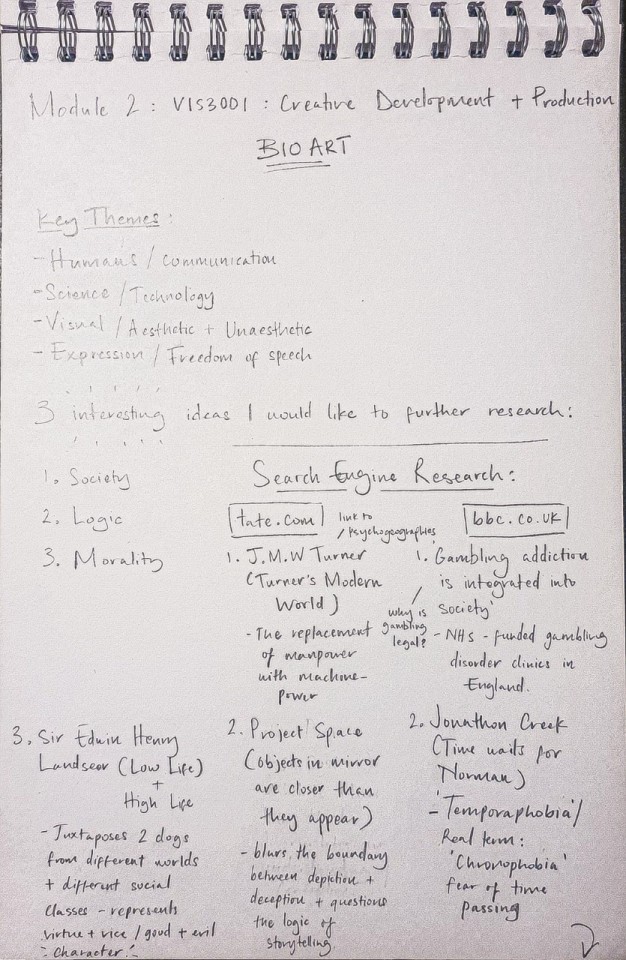

The final part of kickstarting my research was the search engine activity, which involved me taking 3 words or phrases that I found most interesting from my mind map and entering them into a variety of search engines listed by the University. As shown above, my key words / themes were: Society, Logic, and Morality. The first I picked after realising how much society as a whole impacts an individual and their work, the second is something I have always been fascinated in, probably due to my love of debating, and finally the third is something I believe we should all question, especially considering the subjectiveness of morality in a secular society.
The search engines I picked were the following: ‘tate.com’, ‘bbc.co.uk’, and ‘domusweb.it/en’ - the first I am quite familiar with due to A Level Art, the second is one I do not like to visit very often (because of fairly obvious reasons #biased), and for my final search engine, I had chosen an unknown site to try and broaden my findings. Above indicates my rough research, which I intend to explore in the next few posts.
0 notes
Photo

The first activity to kickstart the module was a Mind map on ‘Bio Art’, separated into two words ‘Bio’ and ‘Art’ to further explore the term. We were asked to jot down any related words or ideas, sprouting from each of the two terms and again for each new word / phrase. We were then asked to make connections between the two sides and highlight any interesting words / ideas (as I have done above). Each new layer in my Mind map is represented by a new colour (with my key at the top left hand corner) in order to make it easier for me to see how far I began to develop each idea. For example, the green pin-points areas I would like to do further research in.
0 notes